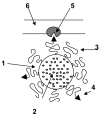Multifunctional and stimuli-sensitive pharmaceutical nanocarriers
- PMID: 18977297
- PMCID: PMC3197821
- DOI: 10.1016/j.ejpb.2008.09.026
Multifunctional and stimuli-sensitive pharmaceutical nanocarriers
Abstract
Currently used pharmaceutical nanocarriers, such as liposomes, micelles, and polymeric nanoparticles, demonstrate a broad variety of useful properties, such as longevity in the body; specific targeting to certain disease sites; enhanced intracellular penetration; contrast properties allowing for direct carrier visualization in vivo; stimuli-sensitivity, and others. Some of those pharmaceutical carriers have already made their way into clinic, while others are still under preclinical development. In certain cases, the pharmaceutical nanocarriers combine several of the listed properties. Long-circulating immunoliposomes capable of prolonged residence in the blood and specific target recognition represent one of the examples of this kind. The engineering of multifunctional pharmaceutical nanocarriers combining several useful properties in one particle can significantly enhance the efficacy of many therapeutic and diagnostic protocols. This paper considers the current status and possible future directions in the emerging area of multifunctional nanocarriers with primary attention on the combination of such properties as longevity, targetability, intracellular penetration, contrast loading, and stimuli-sensitivity.
Figures





References
-
- Torchilin VP, editor. Nanoparticualtes as Pharmaceutical carriers. Imperial College Press; London, UK: 2006.
-
- Domb AJ, Tabata Y, Kumar M.N.V. Ravi, Farber S, editors. Nanoparticles for Pharmaceutical Applications. American Scientific Publishers; Stevenson Ranch, CA: 2007.
-
- Thassu D, Deleers M, Pathak Y, editors. Nanoparticulate Drug Delivery Systems. Informa Healthcare USA; New York, NY: 2007.
-
- Bernkop-Schnurch A, Walker G. Multifunctional matrices for oral peptide delivery. Crit. Rev. Ther. Drug Carrier Syst. 2001;18:459–501. - PubMed
-
- van Vlerken LE, Amiji MM. Multi-functional polymeric nanoparticles for tumour-targeted drug delivery. Expert Opin. Drug Deliv. 2006;3:205–216. - PubMed
Publication types
MeSH terms
Substances
Grants and funding
LinkOut - more resources
Full Text Sources
Other Literature Sources

